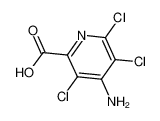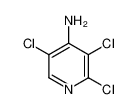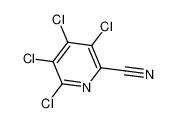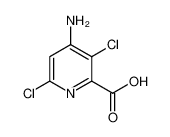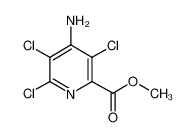1.Identification
1.1 GHS Product identifier
| Product name | picloram |
|---|
1.2 Other means of identification
| Product number | - |
|---|---|
| Other names | 3,5,6-trichloro-4-amino-picolinic acid |
1.3 Recommended use of the chemical and restrictions on use
| Identified uses | For industry use only. Herbicide |
|---|---|
| Uses advised against | no data available |
1.4 Supplier's details
| Company | MOLBASE (Shanghai) Biotechnology Co., Ltd. |
|---|---|
| Address | Floor 4 & 5, Building 12, No. 1001 North Qinzhou Road, Xuhui District, Shanghai, China |
| Telephone | +86(21)64956998 |
| Fax | +86(21)54365166 |
1.5 Emergency phone number
| Emergency phone number | +86-400-6021-666 |
|---|---|
| Service hours | Monday to Friday, 9am-5pm (Standard time zone: UTC/GMT +8 hours). |
2.Hazard identification
2.1 Classification of the substance or mixture
Hazardous to the aquatic environment, long-term (Chronic) - Category Chronic 3
2.2 GHS label elements, including precautionary statements
| Pictogram(s) | No symbol. |
|---|---|
| Signal word | No signal word. |
| Hazard statement(s) | H412 Harmful to aquatic life with long lasting effects |
| Precautionary statement(s) | |
| Prevention | P273 Avoid release to the environment. |
| Response | none |
| Storage | none |
| Disposal | P501 Dispose of contents/container to ... |
2.3 Other hazards which do not result in classification
none
3.Composition/information on ingredients
3.1 Substances
| Chemical name | Common names and synonyms | CAS number | EC number | Concentration |
|---|---|---|---|---|
| picloram | picloram | 1918-02-1 | none | 100% |
4.First-aid measures
4.1 Description of necessary first-aid measures
General advice
Consult a physician. Show this safety data sheet to the doctor in attendance.
If inhaled
Fresh air, rest.
In case of skin contact
Remove contaminated clothes. Rinse and then wash skin with water and soap.
In case of eye contact
Rinse with plenty of water (remove contact lenses if easily possible).
If swallowed
Rinse mouth.
4.2 Most important symptoms/effects, acute and delayed
Exposure Routes: inhalation, ingestion, skin and/or eye contact Symptoms: Irritation eyes, skin, respiratory system; nausea Target Organs: Eyes, skin, respiratory system, liver, kidneys (NIOSH, 2016)
4.3 Indication of immediate medical attention and special treatment needed, if necessary
Skin decontamination. Skin contamination should be treated promptly by washing with soap and water. Contamination of the eyes should be treated immediately by prolonged flushing of the eyes with large amounts of clean water. If dermal or ocular irritation persists, medical attention should be obtained without delay. /Other herbicides/
5.Fire-fighting measures
5.1 Extinguishing media
Suitable extinguishing media
Fire Extinguishing Media: Pathway; water fog, alcohol foam, CO2, dry chemical.
5.2 Specific hazards arising from the chemical
Flash point data for this chemical are not available; however, it is probably combustible.
5.3 Special protective actions for fire-fighters
Wear self-contained breathing apparatus for firefighting if necessary.
6.Accidental release measures
6.1 Personal precautions, protective equipment and emergency procedures
Use personal protective equipment. Avoid dust formation. Avoid breathing vapours, mist or gas. Ensure adequate ventilation. Evacuate personnel to safe areas. Avoid breathing dust. For personal protection see section 8.
6.2 Environmental precautions
Personal protection: particulate filter respirator adapted to the airborne concentration of the substance. Do NOT let this chemical enter the environment. Sweep spilled substance into covered containers. If appropriate, moisten first to prevent dusting. Carefully collect remainder. Then store and dispose of according to local regulations.
6.3 Methods and materials for containment and cleaning up
Pick up and arrange disposal. Sweep up and shovel. Keep in suitable, closed containers for disposal.
7.Handling and storage
7.1 Precautions for safe handling
Avoid contact with skin and eyes. Avoid formation of dust and aerosols. Avoid exposure - obtain special instructions before use.Provide appropriate exhaust ventilation at places where dust is formed. For precautions see section 2.2.
7.2 Conditions for safe storage, including any incompatibilities
Dry. Keep in a well-ventilated room. Separated from : see Chemical Dangers. Provision to contain effluent from fire extinguishing. Store in an area without drain or sewer access.Keep containers closed. Do not cut or weld container.
8.Exposure controls/personal protection
8.1 Control parameters
Occupational Exposure limit values
... NIOSH conducted a limited evaluation of the literature and concluded that the documentation cited by OSHA was inadequate to support the proposed PEL (as an 8-hour TWA) of 10 mg/cu m for ... picloram.
Biological limit values
no data available
8.2 Appropriate engineering controls
Handle in accordance with good industrial hygiene and safety practice. Wash hands before breaks and at the end of workday.
8.3 Individual protection measures, such as personal protective equipment (PPE)
Eye/face protection
Safety glasses with side-shields conforming to EN166. Use equipment for eye protection tested and approved under appropriate government standards such as NIOSH (US) or EN 166(EU).
Skin protection
Wear impervious clothing. The type of protective equipment must be selected according to the concentration and amount of the dangerous substance at the specific workplace. Handle with gloves. Gloves must be inspected prior to use. Use proper glove removal technique(without touching glove's outer surface) to avoid skin contact with this product. Dispose of contaminated gloves after use in accordance with applicable laws and good laboratory practices. Wash and dry hands. The selected protective gloves have to satisfy the specifications of EU Directive 89/686/EEC and the standard EN 374 derived from it.
Respiratory protection
Wear dust mask when handling large quantities.
Thermal hazards
no data available
9.Physical and chemical properties
| Physical state | PHYSICAL DESCRIPTION: Fine beige crystals or white powder. Odor of chlorine. |
|---|---|
| Colour | White powder |
| Odour | Chlorine-like odor |
| Melting point/ freezing point | 200 °C (dec.)(lit.) |
| Boiling point or initial boiling point and boiling range | Decomposes (NIOSH, 2016) |
| Flammability | Combustible SolidCombustible. Gives off irritating or toxic fumes (or gases) in a fire. |
| Lower and upper explosion limit / flammability limit | no data available |
| Flash point | Tordon 22k: 46 deg c toc; tordon 101 mixture--combustible with an toc flash point of 35 deg c; Tordon 155 mixture--104 deg c coc /Tordon/ |
| Auto-ignition temperature | no data available |
| Decomposition temperature | no data available |
| pH | pH of saturated solution 3.0 (24.5°C) |
| Kinematic viscosity | no data available |
| Solubility | In water:420 mg/L |
| Partition coefficient n-octanol/water (log value) | log Kow = 0.30 |
| Vapour pressure | 6.16e-07 mm Hg at 35°C |
| Density and/or relative density | no data available |
| Relative vapour density | no data available |
| Particle characteristics | no data available |
10.Stability and reactivity
10.1 Reactivity
no data available
10.2 Chemical stability
Storage stability: a minimum of 2 years
10.3 Possibility of hazardous reactions
Tordon 10k pellets are nonflammable.PICLORAM may be sensitive to prolonged exposure to light. Aqueous solutions may be decomposed by light. This chemical is incompatible with strong oxidizing agents, strong acids, acid chlorides and acid anhydrides.
10.4 Conditions to avoid
no data available
10.5 Incompatible materials
Hot concentrated alkali (hydrolyzes).
10.6 Hazardous decomposition products
When heated to decomposition it emits very toxic fumes of /hydrogen chloride and nitrogen oxides/.
11.Toxicological information
Acute toxicity
- Oral: LD50 Rat (male, Sprague-Dawley derived) oral 950 mg/kg (95% CI: 812-1120 mg/kg)
- Inhalation: no data available
- Dermal: LD50 Rabbit percutaneous >2000 mg/kg
Skin corrosion/irritation
no data available
Serious eye damage/irritation
no data available
Respiratory or skin sensitization
no data available
Germ cell mutagenicity
no data available
Carcinogenicity
Cancer Classification: Group E Evidence of Non-carcinogenicity for Humans
Reproductive toxicity
no data available
STOT-single exposure
no data available
STOT-repeated exposure
no data available
Aspiration hazard
no data available
12.Ecological information
12.1 Toxicity
- Toxicity to fish: LC50; Species: Salvelinus namaycush (Lake trout) weight 0.3 g; Conditions: static without aeration, 10°C, pH 7.2-7.5, alkalinity 30-35 mg/L, hardness 40-50 mgL as CaCO3; Concentration: 4.3 mg/L for 96 hr @ 10°C (95% confidence limit 4.0-4.5 mg/L), /Technical material 90-100%
- Toxicity to daphnia and other aquatic invertebrates: EC50; Species: Daphnia magna (Water Flea) 1st instar larva; Conditions: freshwater, static; Concentration: 68300 ug/L for 48 hr (95% confidence interval: 63000-75000 ug/L); Effect: intoxication, immobilization /93.8% purity
- Toxicity to algae: EC50; Species: Pseudokirchneriella subcapitata (Green Algae); Conditions: freshwater, static; Concentration: 36790 ug/L for 96 hr (95% confidence interval: 35100-38750 ug/L); Effect: population abundance /93.4% purity
- Toxicity to microorganisms: no data available
12.2 Persistence and degradability
AEROBIC: Possible pathways for aerobic primary degradation of picloram are decarboxylation or amino displacement(1). Soil half-lives for picloram at various initial concentrations were 55 days at 0.25 ppm (7 days lag-phase), 90 days at 0.5 ppm (30 days lag phase), and 180 days at 1.0 ppm (90 days lag phase)(2). Picloram was degraded through aerobic metabolism in seven soils, half-lives ranging from 167 to 513 days, with carbon dioxide being the major degradate(3). Aerobic degradation half-lives for picloram at various application rates were 18 days at 0.0025 ppm, 29 days at 0.025 ppm, 150 days at 0.25 ppm, and 300 days at 2.5 ppm(4). After 100 days incubation in 3 soil types, remaining picloram concentrations were 63 to 77% of the initial concentrations(5). Degradation of 75 to 100% picloram in soils required 18 months(6). No detectable degradation of picloram was observed in 8 weeks in soil with high organic matter content from Pentego, NC(7). In the presence of a mixture containing 0.5% fertile garden soil, yeast, and other organics, picloram persisted >275 days(8). In a 423 day period using a picloram concentration of 0.4 ppm, some soils had 52 to 82.5% of the picloram decomposed and others had only 5.2 and 7.6% decomposed(9). Degradation of picloram in thirteen soils after incubation for 6 months ranged from 0 to 60% at 3 mg/L, from 0 to 84% at 1.5 mg/L, from 5 to 94% at 0.75 mg/L, from 28 to 99% at 0.375 mg/L, from 38 to >99% at 0.188 mg/L, from 32 to >99% at 0.094 mg/L, from 28 to >99% at 0.047 mg/L(10). Most of the soils showed a tendency towards greater percentage detoxification for lower concentrations(10). Picloram was applied at a rate of 10 ppm to five different soils, after 124 days of alternating wet and drying cycles, picloram remained in the soil 82.7 to 91.0% incubated at 30°C and 86.0 to 93.0% incubated at 50°C(11). The amount of non-degraded picloram in groundwater from 4 sites after incubation for 15 weeks (105 days) was 60.8 to 82.4% (average 71.6%) at an initial concentration of 0.72 ppm, and 60.7 to 79.8% (average 67.9%) at an initial concentration of 10.0 ppm(12).
12.3 Bioaccumulative potential
BCFs of 0.11 and 0.54 were reported in bluegill sunfish exposed for 28 days at C14 labeled picloram concentrations of 1.0 and 0.1 mg/L, respectively, using a flow-thru system(1). The BCF of picloram in fish was also measured as 31 using the flowing water method(2-3). According to a classification scheme(4), these BCF values suggest bioconcentration in aquatic organisms is low(SRC).
12.4 Mobility in soil
Experimental Koc values for picloram are 12.7(1-2), 25.2(3), 0.026(4), 17(5), and 25.5(6). Koc values for picloram in soils were 11.1, 22.1, 11.2, 12.5, 18.0, 20.6 and 9.9 at 0.74, 2.92, 1.03, 1.36, 0.45, 1.89, and 1.17% organic carbon, respectively(7). Koc values for 28 different types of pasture soils with varying amounts of organic carbon ranged from 14 to 100(8). According to a classification scheme(9), these Koc values suggest that picloram is expected to have very high to high mobility in soil. The pKa of picloram is 2.3(10), indicating that this compound will exist almost entirely in anion form in the environment and anions generally do not adsorb more strongly to organic carbon and clay than their neutral counterparts(11). Leaching potential is greatest in sandy soils low in organic matter(12-13). Picloram is usually confined to the upper 1 foot (30 cm) when application rates are low (<1 lb/acre, <1.12 kg/ha), but that picloram can readily move to depths >3 feet (approximately 1 meter), even in relatively dry areas, when the application rate is high (3 to 9 lb/acre, 3 to 10 kg/ha)(16).
12.5 Other adverse effects
no data available
13.Disposal considerations
13.1 Disposal methods
Product
The material can be disposed of by removal to a licensed chemical destruction plant or by controlled incineration with flue gas scrubbing. Do not contaminate water, foodstuffs, feed or seed by storage or disposal. Do not discharge to sewer systems.
Contaminated packaging
Containers can be triply rinsed (or equivalent) and offered for recycling or reconditioning. Alternatively, the packaging can be punctured to make it unusable for other purposes and then be disposed of in a sanitary landfill. Controlled incineration with flue gas scrubbing is possible for combustible packaging materials.
14.Transport information
14.1 UN Number
| ADR/RID: no data available | IMDG: no data available | IATA: no data available |
14.2 UN Proper Shipping Name
| ADR/RID: no data available |
| IMDG: no data available |
| IATA: no data available |
14.3 Transport hazard class(es)
| ADR/RID: no data available | IMDG: no data available | IATA: no data available |
14.4 Packing group, if applicable
| ADR/RID: no data available | IMDG: no data available | IATA: no data available |
14.5 Environmental hazards
| ADR/RID: no | IMDG: no | IATA: no |
14.6 Special precautions for user
no data available
14.7 Transport in bulk according to Annex II of MARPOL 73/78 and the IBC Code
no data available
15.Regulatory information
15.1 Safety, health and environmental regulations specific for the product in question
| Chemical name | Common names and synonyms | CAS number | EC number |
|---|---|---|---|
| picloram | picloram | 1918-02-1 | none |
| European Inventory of Existing Commercial Chemical Substances (EINECS) | Listed. | ||
| EC Inventory | Listed. | ||
| United States Toxic Substances Control Act (TSCA) Inventory | Listed. | ||
| China Catalog of Hazardous chemicals 2015 | Not Listed. | ||
| New Zealand Inventory of Chemicals (NZIoC) | Listed. | ||
| Philippines Inventory of Chemicals and Chemical Substances (PICCS) | Listed. | ||
| Vietnam National Chemical Inventory | Not Listed. | ||
| Chinese Chemical Inventory of Existing Chemical Substances (China IECSC) | Not Listed. | ||
16.Other information
Information on revision
| Creation Date | Aug 16, 2017 |
|---|---|
| Revision Date | Aug 16, 2017 |
Abbreviations and acronyms
- CAS: Chemical Abstracts Service
- ADR: European Agreement concerning the International Carriage of Dangerous Goods by Road
- RID: Regulation concerning the International Carriage of Dangerous Goods by Rail
- IMDG: International Maritime Dangerous Goods
- IATA: International Air Transportation Association
- TWA: Time Weighted Average
- STEL: Short term exposure limit
- LC50: Lethal Concentration 50%
- LD50: Lethal Dose 50%
- EC50: Effective Concentration 50%
References
- IPCS - The International Chemical Safety Cards (ICSC), website: http://www.ilo.org/dyn/icsc/showcard.home
- HSDB - Hazardous Substances Data Bank, website: https://toxnet.nlm.nih.gov/newtoxnet/hsdb.htm
- IARC - International Agency for Research on Cancer, website: http://www.iarc.fr/
- eChemPortal - The Global Portal to Information on Chemical Substances by OECD, website: http://www.echemportal.org/echemportal/index?pageID=0&request_locale=en
- CAMEO Chemicals, website: http://cameochemicals.noaa.gov/search/simple
- ChemIDplus, website: http://chem.sis.nlm.nih.gov/chemidplus/chemidlite.jsp
- ERG - Emergency Response Guidebook by U.S. Department of Transportation, website: http://www.phmsa.dot.gov/hazmat/library/erg
- Germany GESTIS-database on hazard substance, website: http://www.dguv.de/ifa/gestis/gestis-stoffdatenbank/index-2.jsp
- ECHA - European Chemicals Agency, website: https://echa.europa.eu/

